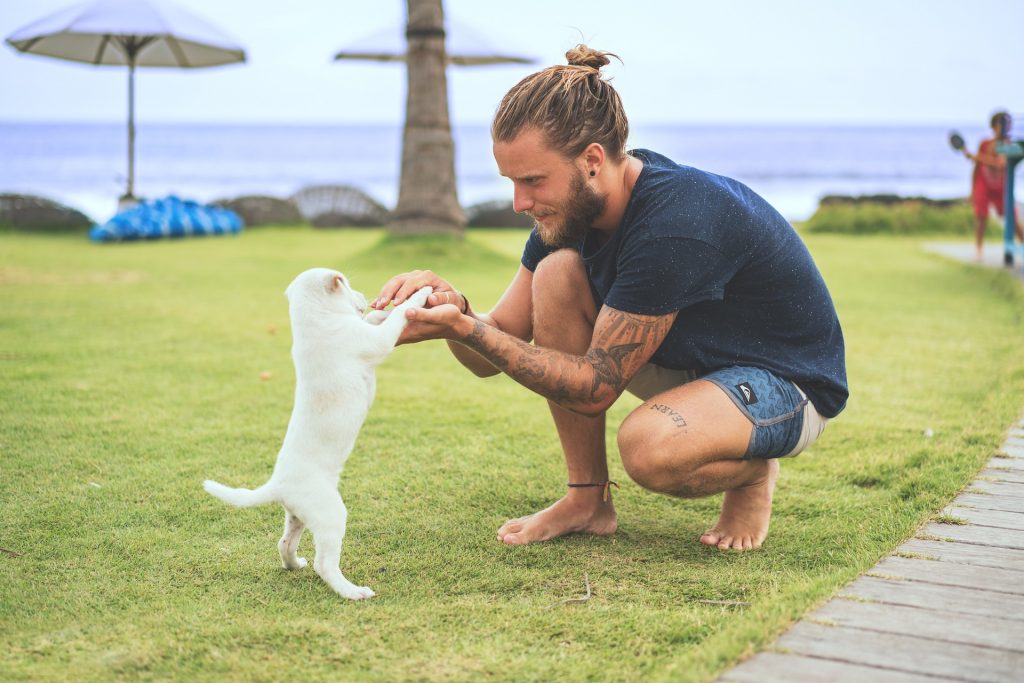 Summer is here and in full swing in Southern California. You may spend a lot of time trying to keep cool during these hot summer days, but are you remembering your beloved pets?
Summer is here and in full swing in Southern California. You may spend a lot of time trying to keep cool during these hot summer days, but are you remembering your beloved pets?
Pets suffer from the same problems humans do, like overheating, dehydration and sunburn. By taking some simple precautions, you and your pet can enjoy the summer months.
Keep your pet cool Dogs are much less efficient at cooling themselves than people, so they are more susceptible to overheating. A dog’s normal body temperature is 100-102 degrees, and they have sweat glands on their nose and pads of their paws. They pant and drink water to cool down, so be sure to have fresh, cool water available for your dog- whether on a walk, in the car or in a tip-proof bowl in the house or yard. If your dog is an outdoor dog, always bring him inside during the hottest hours of the day. Provide a shaded area in the yard, preferably in a well-constructed doghouse, making sure he always has access to cool water, since the hot sun can quickly make water too hot to drink.
Heat exhaustion in dogs is often caused by dehydration and overheating from running or over-exercising during hot weather. Heatstroke in your dog can occur when your dog’s body temperature is too high for a prolonged period of time. Unfortunately, this can lead to brain and organ damage, heart failure and even death. Short-nosed, thick-coated breeds and puppies, seniors, and dogs with respiratory, cardiovascular and other health problems are especially susceptible.
Some of the signs of heatstroke are panting hard, staggering gait, rapid heartbeat, dazed look, listlessness, restlessness, dark red or purple gums and/or tongue and vomiting. If you suspect a heat-induced illness in your dog, gradually lower his body temperature by moving him to the shade or air conditioning, apply cold packs to his head, neck or belly, or immerse in cool (not cold) water, giving small amounts of cool water or ice cubes to lick — and then take him to the vet immediately.
There are many products on the market that can also help keep your dog cool. Consider a bed that can be filled with cool water and stays dry for your dog to rest on. There are also cooling pads (for laying down), vests (that wrap around your dog’s belly) and cooling bandanas and collars (wrapping around his neck) filled with nontoxic polymer crystals that expand in water and cool your pet for hours as the water evaporates. Simply soak the reusable and hand-washable item in cool water for 15-30 minutes, towel dry and place on your dog. These work great, but should not be a substitution for bringing your dog indoors during the hottest parts of the day if you choose to keep your pet primarily outdoors.
Never, never, never leave your pet alone in a car during hot weather Culturally, dogs are more a part of our life and our lifestyle than ever before- they come along for a ride in the car- whether running errands or a family vacation. Just as with children, we must be aware of the danger in leaving our dog inside a parked car in the summer heat. Simply parking in the shade or leaving the windows cracked is not enough. Windows collect light and trap heat inside the car, sending the temperature to dangerous and deadly levels rapidly. Moreover, it’s a painful and horrible way to die. In most states, including California, it’s against the law to leave a pet unattended in a parked vehicle in a manner that endangers the health or safety of the animal. A car’s inside temperature can increase as much as 40 degrees in an hour — with 80 percent of that increase within the first 30 minutes. On an 85-degree day, the temperature inside a car with the windows cracked slightly can reach 102 degrees within 10 minutes!
Carry two car keys with you, so if you have to leave your dog in the car for even a few minutes, you can leave the engine running and the air conditioning on, with your dog inside and the doors locked. Take the second key with you so you can open the door when you return. If you see a pet in a parked car on a hot summer day, go to the nearest store to have the owner paged, enlist the help of a security guard or call the local police.
Plan for power outages If you leave your dog home alone with the air conditioning on (and all the windows closed) while you’re at work all day, and you live in an area where brownouts or rolling blackouts occur during peak times of power usage, make sure a neighbor who will be at home has your house key. That way your neighbor can check on your dog and open all the windows if the power goes out.
Protect your dog from sunburn Many people don’t realize that dogs can get a sunburn! It’s especially common in pale (light or white hair) and short-haired dogs, usually on the bridge of the nose and tips of the ears as well as the belly, groin and insides of the legs (because of the sunlight that reflects up from the sidewalk and hot sand on the beach). Use a sunscreen that is labeled specifically for use on animals and apply it to your dog’s nose and his ear tips. You can’t put sunscreen on his underside because he’ll lick it off, so be careful when walking your dog or taking him to the beach in the hot sun. If you shave your dog’s coat in the summer, be aware that it will make him more prone to sunburn.
Protect your dog’s paws Dogs’ paws can get burned on sidewalks, asphalt, and sand during peak sun and heat. Check the temperature of the surface with your hand before walking your dog — if it’s too hot for your hand, it’s too hot for your dog’s paws. Walk during early morning or evening hours and never just after a meal. If you must walk your dog during the afternoon, make it short and keep him on the grass or at the water’s edge when at the beach to protect his paws.
Think twice before a day at the beach Don’t take your dog to the beach unless you can guarantee a shaded spot. The hot sand reflects the sun and heats up your dog quickly. Always remember to take fresh water along- drinking salt water can dehydrate your dog. Make sure to rinse your salty dog off after a dip in the ocean.
Supervise the backyard pool Each year, puppies, dogs and small children accidentally drown in backyard swimming pools when left unattended. Not all dogs are natural swimmers, and all should be supervised when in the water. Unless she knows how to get out of the pool, your dog’s quick dip to cool off can result in tragedy — so make sure to teach her where the steps and ladder are and how to swim to them, so she doesn’t exhaust herself finding a way to get out. Don’t allow your dog free access to the pool and always supervise her when she takes the plunge.
Dogs are part of the family, so remember to give them the same hot weather care and protection you would want for yourself because they deserve it!
The information provided is for general interest only and should not be misconstrued as a diagnosis, prognosis or treatment recommendation. This information does not in any way constitute the practice of medicine, or any other health care profession. Readers are directed to consult their health care provider regarding their specific health situation. Marque Medical is not liable for any action taken by a reader based upon this information.


